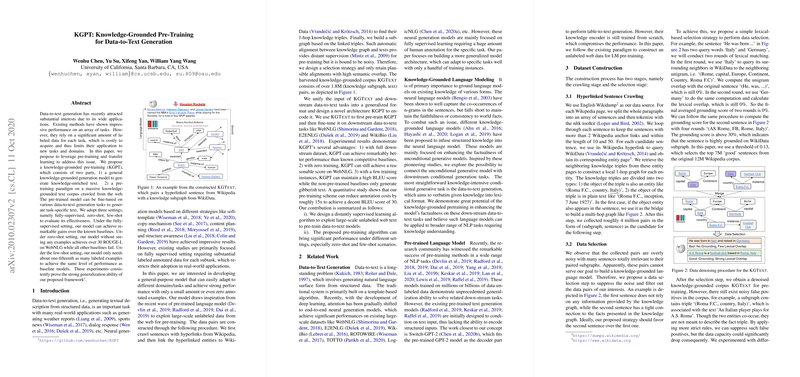An Analysis of "KGPT: Knowledge-Grounded Pre-Training for Data-to-Text Generation"
This paper presents a novel approach to data-to-text generation, focusing on reducing the dependency on large amounts of labeled data typically required for state-of-the-art performance. The authors introduce a knowledge-grounded pre-training framework (KGPT), which leverages a general knowledge-enhanced generation model pre-trained on a massive corpus of knowledge-grounded text from the web. The core objective is to enable effective text generation in fully-supervised, zero-shot, and few-shot settings.
Key Contributions
- Pre-Training Paradigm: KGPT utilizes a dual architecture paradigm involving a large-scale unsupervised pre-training phase followed by fine-tuning on specific tasks. This approach addresses the typical issue of data sparsity in novel domains, enabling the model to generalize effectively across various data-to-text generation tasks with minimal domain-specific data.
- Knowledge Graph Utilization: The pre-training process involves the creation of a complex corpus—KGText—from Wikipedia and Wikidata. This involves concatenating sentences with hyperlinks to build knowledge subgraphs to form the foundational dataset for pre-training. This alignment with knowledge resources enables the model to retain high semantic overlap and factual integrity, albeit with inherent noise filtered through a selection mechanism.
- Flexible Encoder Designs: The model employs two distinct encoders—a graph encoder and a sequence encoder—both instrumental in capturing the syntactic nuances of structured inputs. These complement an auto-regressive transformer-based decoder augmented with a copy mechanism, facilitating a robust generation process.
- Experimental Evaluation: KGPT is evaluated on multiple benchmarks, including WebNLG, E2ENLG, and WikiBio, demonstrating superior performance over state-of-the-art models in various feasibility conditions. The model achieves remarkable zero-shot performance with over 30 ROUGE-L on WebNLG despite other baselines' inability to produce meaningful output. Moreover, under few-shot training conditions, it requires significantly fewer examples (up to 15 times less) to achieve comparable results to fully supervised settings.
Implications
The findings of this research have substantial implications for AI-driven natural language generation (NLG) tasks. By reducing the dependence on domain-specific labeled data, KGPT opens the door for scalable deployment of generative models across diverse fields without incurring prohibitive annotation costs. This could significantly influence industries relying on report generation or description tasks, such as summarizing financial reports or generating personalized narratives.
On a theoretical level, the paper propels further innovation in grounding LLMs with explicit knowledge and fine-tuning them for task-specific requirements. The model's versatility in adapting to varying data structures with minimal data alludes to broader applications in other NLP tasks that require structured data understanding.
Future Directions
Given the strengths and challenges highlighted in the paper, future work could explore refining the noise reduction in the knowledge alignment process to enhance factual consistency further. Additionally, extending KGPT's ability to handle more diverse and complex data inputs and increase cross-domain adaptability remains a promising avenue. The development and refinement of knowledge-grounded models with a focus on efficiency and factual grounding will undeniably contribute to the evolution of AI-driven text generation.
Overall, KGPT marks a significant contribution to the data-to-text generation sphere, setting a precedent for leveraging knowledge graphs and large unlabelled corpora to enhance model performance in sparse data environments.
